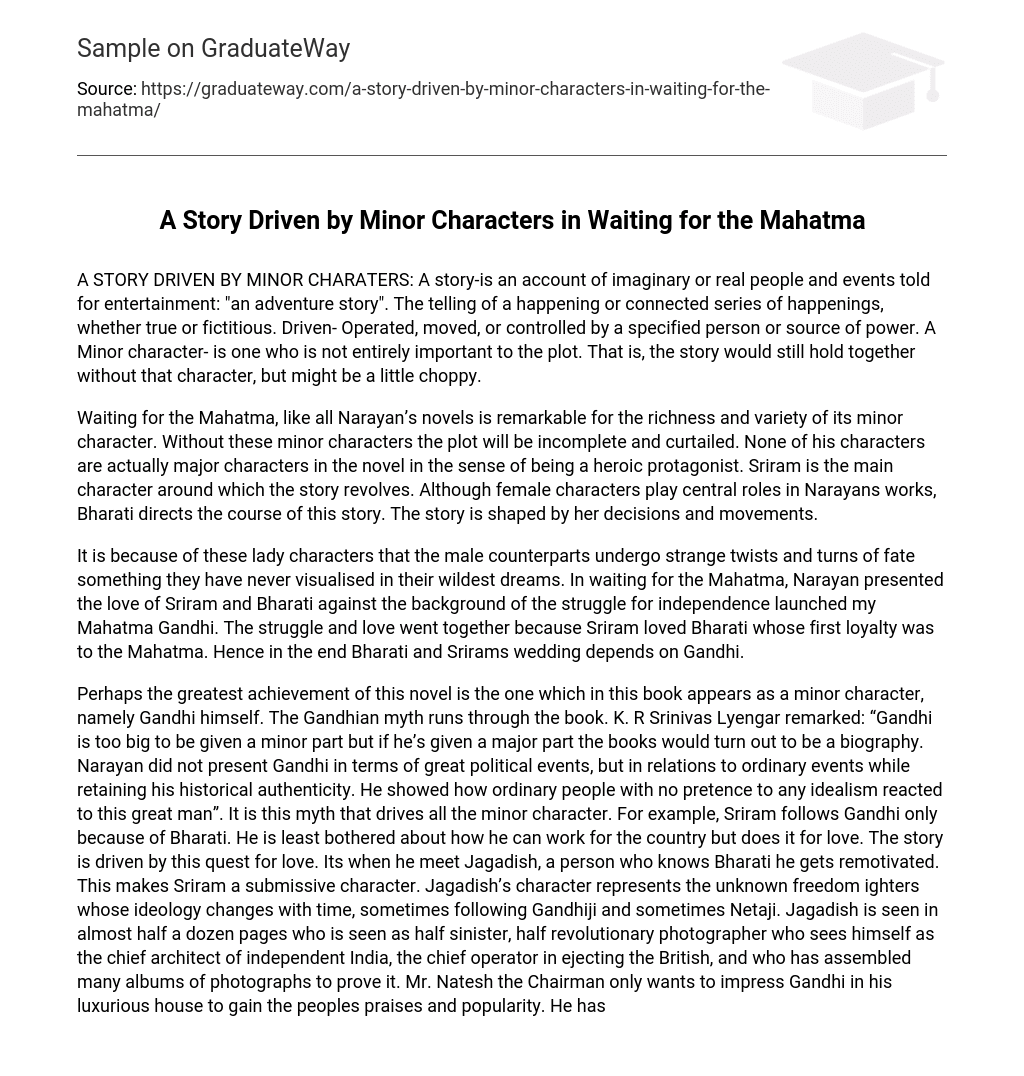A story-is an account of imaginary or real people and events told for entertainment: “an adventure story”. The telling of a happening or connected series of happenings, whether true or fictitious. Driven- Operated, moved, or controlled by a specified person or source of power. A Minor character- is one who is not entirely important to the plot. That is, the story would still hold together without that character, but might be a little choppy.
Waiting for the Mahatma, like all Narayan’s novels is remarkable for the richness and variety of its minor character. Without these minor characters the plot will be incomplete and curtailed. None of his characters are actually major characters in the novel in the sense of being a heroic protagonist. Sriram is the main character around which the story revolves. Although female characters play central roles in Narayans works, Bharati directs the course of this story. The story is shaped by her decisions and movements.
It is because of these lady characters that the male counterparts undergo strange twists and turns of fate something they have never visualised in their wildest dreams. In waiting for the Mahatma, Narayan presented the love of Sriram and Bharati against the background of the struggle for independence launched my Mahatma Gandhi. The struggle and love went together because Sriram loved Bharati whose first loyalty was to the Mahatma. Hence in the end Bharati and Srirams wedding depends on Gandhi.
Perhaps the greatest achievement of this novel is the one which in this book appears as a minor character, namely Gandhi himself. The Gandhian myth runs through the book. K. R Srinivas Lyengar remarked: “Gandhi is too big to be given a minor part but if he’s given a major part the books would turn out to be a biography. Narayan did not present Gandhi in terms of great political events, but in relations to ordinary events while retaining his historical authenticity. He showed how ordinary people with no pretence to any idealism reacted to this great man”. It is this myth that drives all the minor character.
For example, Sriram follows Gandhi only because of Bharati. He is least bothered about how he can work for the country but does it for love. The story is driven by this quest for love. Its when he meet Jagadish, a person who knows Bharati he gets remotivated. This makes Sriram a submissive character. Jagadish’s character represents the unknown freedom ighters whose ideology changes with time, sometimes following Gandhiji and sometimes Netaji. Jagadish is seen in almost half a dozen pages who is seen as half sinister, half revolutionary photographer who sees himself as the chief architect of independent India, the chief operator in ejecting the British, and who has assembled many albums of photographs to prove it. Mr. Natesh the Chairman only wants to impress Gandhi in his luxurious house to gain the peoples praises and popularity. He has none of the Gandhian values.
The collector as well only wants to impress Gandhi when he says to the Chairman, “have you so little sense, that you could not have delayed Mr. Gandhi’s visit atleast by 2 hours time, to give the people a chance to sweep and clean that awful place”…the place which Gandhi opts to live in. Sriram’s granny is a woman of extreme devotion, touchiness, orthodoxy and individuality. She mocks Gandhi and speaks ill about him saying that he doesn’t differentiate between people of various castes, that “he preaches dangerously, who involved people in difficulties with the police. It is Srirams Granny who brought him up, gave him money, and set goals in his life. She played a major role in Srirams life. Local businessmen worry more about their daily earnings. Very few like Bharati and Gorpad follow the objectives of the freedom struggle. Hence we see that the entire story revolves around the Mahatma as a myth which acts as the backdrop of this novel. Since Narayan is exceptional at potraying his own created characters his story is driven by his minor characters.





